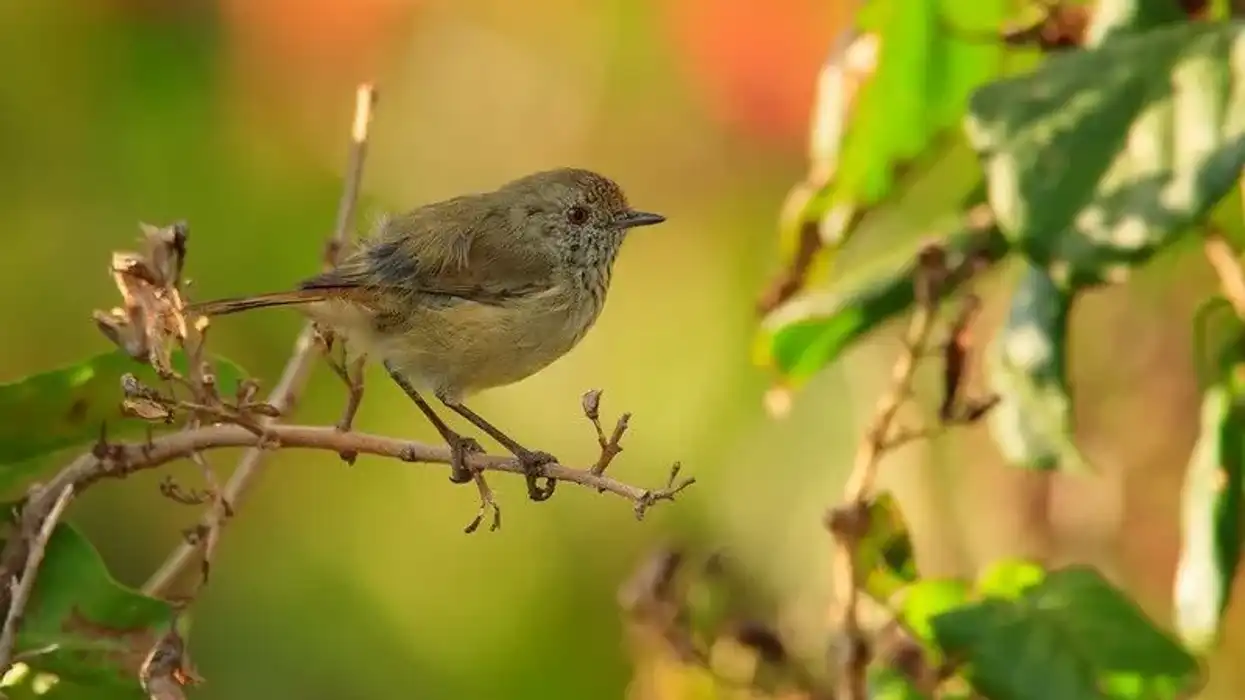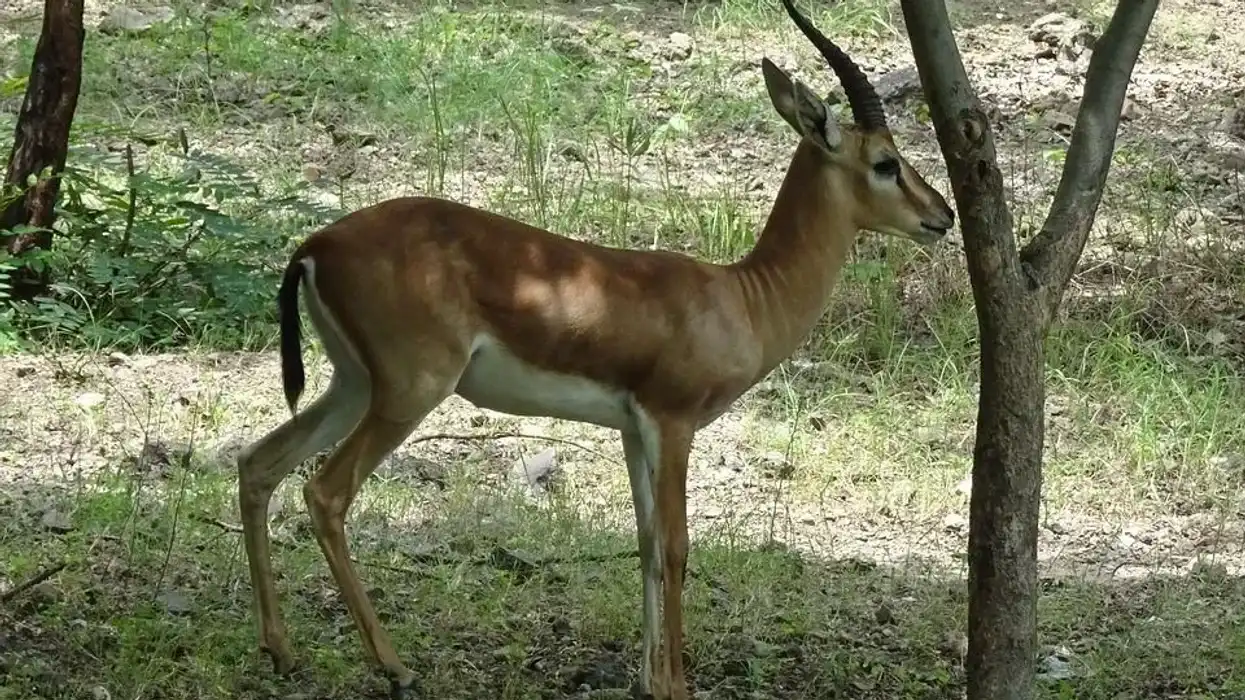The malabar grey hornbill (Ocyceros griseus) is a bird species endemic to the Western Ghats and a smaller range of hills associated with it in southern India. Malabar grey hornbill habitat is found mainly in dense forests with large trees near rubber and coffee plantations.
It is grey in color and lacks the prominent casque present in the description of other species of hornbills. Males have an orange bill with a yellow tip and a black stripe, while females have a pale yellow bill.
The malabar grey hornbill female lays three to four eggs during the breeding season and stays inside the nest after blocking the entrance, while the malabar grey hornbill male gets food to the nest.
The malabar grey hornbill diet consists of figs, fruits, berries, and insects as food. The malabar grey hornbill (Ocyceros griseus) has a loud cackling call which sounds like a person laughing.
For more relatable content, check out these toco toucan facts and Amazon parrot facts for kids.
Malabar Grey Hornbill Interesting Facts
What type of animal is a Malabar grey hornbill?
The malabar grey hornbill (Ocyceros griseus) is a flight bird belonging to the genus Ocyceros.
What class of animal does a Malabar grey hornbill belong to?
The malabar grey hornbill (Ocyceros griseus) belongs to Aves, a birds or flight animals class.
How many Malabar grey hornbills are there in the world?
The exact number of malabar grey hornbill (Ocyceros griseus) is unknown; it is categorized as Vulnerable according to the IUCN Red List in 2020, before which it was Least Concern.
Where does a Malabar grey hornbill live?
The natural habitats of the malabar grey hornbill (Ocyceros griseus) are dense forests with large trees near rubber or coffee plantations.
What is a Malabar grey hornbill's habitat?
The malabar grey hornbill range map distribution shows that its habitats are located in the Western Ghats and its associated hills region in southern India. Several large rubber and coffee plantation are lining the hills in this region, which makes them a common sight to see in the hills.
Who do Malabar grey hornbills live with?
Malabar grey hornbill (Ocyceros griseus) flock with 6-20 birds of its species and lives in the tall fruit trees.
How long does a Malabar grey hornbill live?
Hornbills are typically long-living birds. The malabar grey hornbill (Ocyceros griseus) has a generation length of 10.3 years.
How do they reproduce?
The malabar grey hornbill (Ocyceros griseus) reproduces by laying eggs. The female lays three to four eggs in January during the breeding season, which typically hatch in early April.
The female nests in a tree cavity and blocks the entrance to the nest with cement made of her droppings. The male stays outside the nest and brings food to her and the young.
Food is regurgitated and brought to the male's large beak tip and is used for feeding the female and chicks. The same nest is reused by the pair year after year.
What is their conservation status?
The IUCN Red List has categorized malabar grey hornbill (Ocyceros griseus) as Vulnerable.
Malabar Grey Hornbill Fun Facts
What do Malabar grey hornbills look like?
The malabar grey hornbill appearance consists of grey-colored feathers. It has a 9.1 in (23 cm) long tail and malabar grey hornbill wingspan of around 17.7 in (45 cm).
The malabar grey hornbill beak, which they use for feeding, differs slightly for the male and female of this species; the male has an orange bill with a black stripe and yellow tip, while the female's beak is entirely pale yellow.
The female malabar grey hornbill (Ocyceros griseus) has black irises, while the male has beautifully contrasting yellowish-orange irises. A unique physical feature of this hornbill species is that it lacks a casque found mainly on other hornbill species in the world.
How cute are they?
The malabar grey hornbill (Ocyceros griseus) are pleasant to look at despite their dull-colored plumage. The malabar grey hornbill has a loud cackling call which is very infectious as it sounds like laughing people.
How do they communicate?
The malabar grey hornbill (genus Ocyceros) usually communicates using its voice. Its call is a loud cackling sound that is often associated with the sound of humans laughing.
This bird species is known not to use its voice when the male brings food to the nest while the female is confined inside. The male taps the tree to alert her of his presence.
How big is a Malabar grey hornbill?
The malabar grey hornbill (Ocyceros griseus) is a large-sized bird 18 - 23 in (45 to 58 cm) long but is still the smallest of all the Asian hornbill species. This species is half the size of a great hornbill and twice a black dwarf hornbill.
How fast can a Malabar grey hornbill fly?
While the flight speed of this genus is not known, hornbills can fly at 18 mph (30 kph). Their large wings are mainly responsible for their high speeds while flying.
How much does a Malabar grey hornbill weigh?
The malabar grey hornbill of genus Ocyceros weighs a moderate 8.49 oz (240 g) in comparison to other hornbill species like rhinoceros hornbill, which weighs 87-104 oz (2465-2960 g).
What are the male and female names of the species?
There are no specific names used to differentiate these male and female birds, which are endemic to the Western Ghats. They are simply referred to as male or female malabar grey hornbills. There are plenty of visual cues to differentiate between the two sexes.
What would you call a baby Malabar grey hornbill?
There is no specific name to refer to a baby malabar grey hornbill (Ocyceros griseus). The chicks have brown upperparts, yellow bill, and white or yellow irises in terms of appearance.
What do they eat?
The diet of malabar grey hornbills includes berries, figs, insects, small rodents, and reptiles are included in the diet. Typically, the male and female both search for food and prey, but when the female begins nesting in seclusion, the responsibility of feeding her and the young ones falls on the male.
Are they poisonous?
No, the malabar grey hornbill (Ocyceros griseus) is not poisonous.
Would they make a good pet?
No, the malabar grey hornbill is a wild bird whose population is already being threatened by habitat destruction. It is best to leave them alone and let the unique loud cackling and laughing voices associated with this hornbill species resonate in the forest region of India.
Did you know...
The malabar grey hornbill (Ocyceros griseus) is a frugivore that feeds on raw fruits like figs or succulent plants like roots, shoots, nuts, and seeds. They are known as the gardeners of forests because of their essential contribution to the process of seed dispersion.
The malabar grey hornbill shares many similarities with the Sri Lanka Hornbill and Indian Grey Hornbill, which stay in less dense forests.
The malabar grey hornbill (Ocyceros griseus) is a secondary cavity nester, which means that it cannot create tree cavities of its own and resides in already existing tree cavities. Once the nest is built in the cavity, it can be reused every year.
Acorn woodpeckers are primary cavity nesters, and the western bluebird is a secondary cavity nester like hornbills.
D0 Malabar grey hornbills migrate?
The malabar grey hornbill (Ocyceros griseus) is a non-migratory, resident bird, and hence there is no malabar grey hornbill migration pattern. Juveniles fly out of the nest and stay within the range. These hornbills only travel locally to search for food.
Is the Malabar grey hornbill endangered?
The malabar grey hornbill (Ocyceros griseus) isn't endangered yet but is categorized as Vulnerable in the IUCN Red List. They were classified as Least Concern till 2019. There has been a rapid decrease in their population in the past few years due to habitat destruction at a rate of 30-49% over three generations.
Here at Kidadl, we have carefully created lots of interesting family-friendly animal facts for everyone to discover! For more relatable content, check out these Amazon parrot facts and American pipit facts pages.
You can even occupy yourself at home by coloring in one of our free printable malabar grey hornbill coloring pages.









